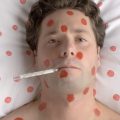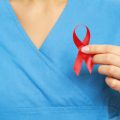Fungal diseases, bears the name of the multi-colored or scaly skin disease in humans comes top layer of skin lesion - epidermis, as in pityriasis versicolor, the process involved the mouth of the hair follicles. Usually, the disease is non-inflammatory in nature and is characterized by a low degree of kontageoznosti - that is,, simply put, it relates to a disease of the skin malozaraznym.
note! Contrary to popular opinion among the inhabitants, chromophytosis is not a disease with high transmissibility!
The emergence and development of the disease provokes a lipophilic yeast fungus with a beautiful name Pityrosporum Orbiculare, replicates in the horny layer of human epidermis.
The name "shingles" (lat. – Lichen) It came into use during the time of the famous Hippocratic. Under this title scientist has combined many skin diseases, the main feature of which was the appearance of the patient's skin at the colored spots, accompanied by desquamation. A causative agent of the disease was first described by Dr. D. Robin in 1853 year, and then only to the 1951 by M. Gordon were isolated yeasts oval shape and round shape. On the skin of the sick they were located in areas like, with signs of tinea versicolor, and in areas visually normal skin of the patient.
In conducting microscopy scrapings from the spot tinea versicolor fungus identified acinar conglomerates, which are located in the skin in the form of thick bent threadlike strands.
The causes of the disease
Multicolored chromophytosis a man also called colored lichen. All these names refer to the same illness. Yeast fungal microorganisms, provoking its development, may be on healthy skin and not cause any inconvenience to man, They are opportunistic pathogens.
but, if a:
- People exposed to certain stress;
- or he has a chronic disease;
- for whatever reason, it causes low immunity;
- or increased sweating;
- or there is a hormonal crash;

Simply put, if the organism ceases to be in a balanced position, then the fungus, usually, It begins to multiply with great speed, which causes as a result of the development of symptoms tinea versicolor.
So before, you start looking for a way to cure chromophytosis, We need to examine the patient to the maximum in order, to find out, for whatever reason, the causative agent of the disease began to multiply uncontrollably in the body of an infected person. When the cause is identified, need to, curing the symptoms of lichen, parallel to try to eliminate the cause - that is,, cure the underlying disease or to stop its worsening. In some cases, after the elimination of the primary disease - pityriasis versicolor extends itself.
The largest number of cases of pityriasis versicolor accounts for young and school-age population (children from 10 s and young people). Pityriasis versicolor in children of preschool age and older people 65 years is extremely rare.
Important! According to most medical causes of the pathological process are not so much the fungus, many factors, provoking its uncontrolled proliferation of skin, such, as:
- predisposition to disease hereditary nature dermatomycosis;
- increase in oily skin (increased sebum secretion) imbalance or otherwise in physiological processes, occurring in the stratum corneum of human epidermis;
- disease, associated fungal attack: diabetes, disease of the ovaries and other endocrine organs, causing hormonal imbalance;
- vegetative neurosis;
- gastrointestinal disease, diseases of the pancreas and liver;
- overweight;
- bronchopneumonia, asthma and other respiratory diseases;
- pregnant or menopausal women;
- excessive sweating with altered chemical composition perspiration, Skin contact with which it contributes to the disruption of the acid-base balance, leading to enhanced proliferation of opportunistic microflora;
- initial reduction in the patient's immune system or secondary immunodeficiencies, developing in a patient with dental caries, tonsillitis, various forms of tuberculosis pyelonephritis and other chronic diseases.

Therefore, each treating doctor, thinking about, how to cure chromophytosis each particular patient, I must do everything, to detect and minimize those factors, which provoke the development of the pathological process.
note! If a young child found similar symptoms, you should immediately consult a dermatologist, because in addition to tinea versicolor there are other diseases with a similar flow pattern, which can be quite serious.
Chromophytosis a person - symptoms
The symptoms of this disease relates primarily to the formation of skin spots patient asymmetrical, which are beginning to appear in various parts of the body and can be a variety of shades. They may have a brownish tint, yellow and pink, for the disease got its second name - multi-colored or colored shingles. Over time, the spots coalesce into large pockets, with jagged edges. their color often changes. After the Sun in their place are the white spots,
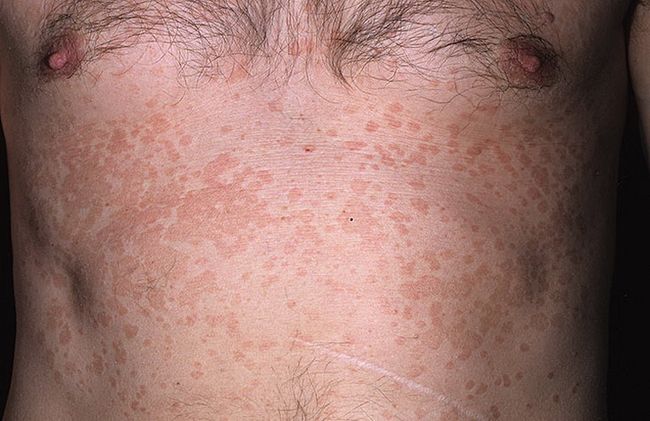
and in winter they can become dark brown.
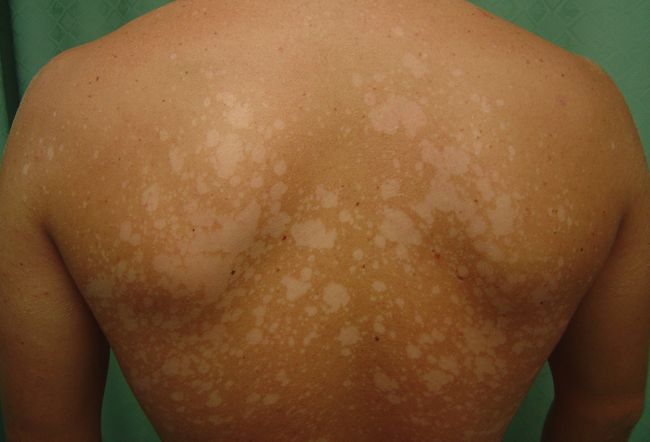
Despite, that most elements are located on the shoulders, the abdomen and the neck of the patient, occasionally they may affect and scalp, but at the same time, Unlike ringworm, Hair structure themselves absolutely unchanged. So that, when a patient is diagnosed chromophytosis color, he does not need to be afraid of baldness. but, focus processing will be carried out much easier, if the hair in the affected area will vystrizheny.

Elements of tinea versicolor in the face form is rarely. Despite the current treatment, disease can with varying degrees of success to give in therapy and recur again within a few years, and sometimes the spots may appear later, even decades after the debut of the disease. Visual manifestation of the disease resembles shingles Gibert. by this, differentiate these two diseases and prescribe adequate effective treatment of tinea versicolor in humans, picking the right products for that, It can only be a specialist, i.e, dermatologist.
Diagnostics
For diagnostic assay is carried out with iodine Balzer (lubricating the affected skin with a five per cent solution of iodine). Struck fungus very friable horny layer absorbs iodine, and spot tinea versicolor really stand out sharply against the background of healthy skin (Leather - yellowish, spots - dark brown). Sometimes iodine solution in this test can be replaced by aniline.
When conducting microscopy scraping with pathological nidus complexes detected filaments yeast fungus, characterized by a specific type of cell - rounded and budding.
Under quartz ultraviolet Wood's lamp in a darkened lesions tinea versicolor sanctified reddish-yellow or brownish glow.
Treatment
so, than to treat scaly skin disease in humans? The most effective and safe methods of treatment include patients receiving both medications, and methods of non-pharmacological treatment.
If the spots are small and are located in small areas of the skin, the treatment is usually local - ointment or cream tinea versicolor, manufactured based antifungal component, such, as:
- ketoconazole,
- ʙifonazol,
- flutrimazole,
- clotrimazole,
- Naphtifine,
- terbinafine.
With the localization of lesions on the scalp apply lotions and shampoos, which are also a part of anti-fungal components: sulfide Selena, zinc pyrithione, tiosulyfat sodium and ketoconazole. All these substances are practically not absorbed into the blood and act only locally.
note! In the treatment of tinea versicolor in children should be chosen the most sparing methods and in no case be self-medicate, Only a dermatologist will be able to designate drugs in adequate doses child, given its condition, comorbidities, age and body weight. improper treatment, that "sin" parents, It can lead to the spread and prolonged duration of disease.
Watch carefully, the child is not combed itchy skin, since in place scratching frequently occurs accession secondary infection. A doctor in some cases, prescribe antihistamines and antipruritic.
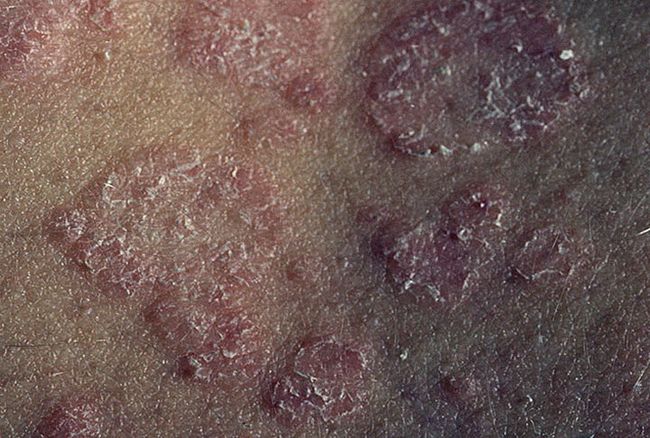
When protracted course of tinea versicolor cure it becomes much more difficult, as the process becomes generalized form. Then the treating doctor dermatologist prescribed to patients systemic medications - pills for tinea versicolor.
additional techniques, or so-called "national treatment" perfectly combined with basic therapy, but can not replace it. These include summer sunbathing, reduce the activity of any of the fungus, wash tar soap, rubbing the affected areas with herbal infusions (train, chamomile), And so on. Folk remedies complement the basic methods of treatment tinea versicolor and promote faster patient recovery, as well as increase the comfort of the treatment.
During the treatment period and upon its completion the patient should be carried out daily wet cleaning with disinfectants. Besides, It is recommended as often as possible to wash all Underwear, linens patient and towels in a washing machine at a temperature of + 95-100 ° C. all clothing, which the patient is, you need to very carefully to iron on each side.
Reviews on the Internet suggest that, that the only way to completely and permanently get rid of this unpleasant disease.
preventive measures
be sure to disinfect the headgear for the prophylaxis of recurrences of infection and pityriasis versicolor, clothes, bed linen and patient's underwear by boiling it in a 2% soap-soda solution and ironed with a hot iron, preferably with a steam generator.
It is necessary to minimize the temperature differences, stresses, heavy load, observe body hygiene, Avoid synthetic clothing, frequently wash your hair. Do not ignore the hardening, We need to strengthen the immune system and establish a balanced diet regime, thus reducing the risk of recurrence. Besides, a person needs, as mentioned above, pay attention to those causes, that provoked the initial development of the disease, and make every effort to complete their elimination.










